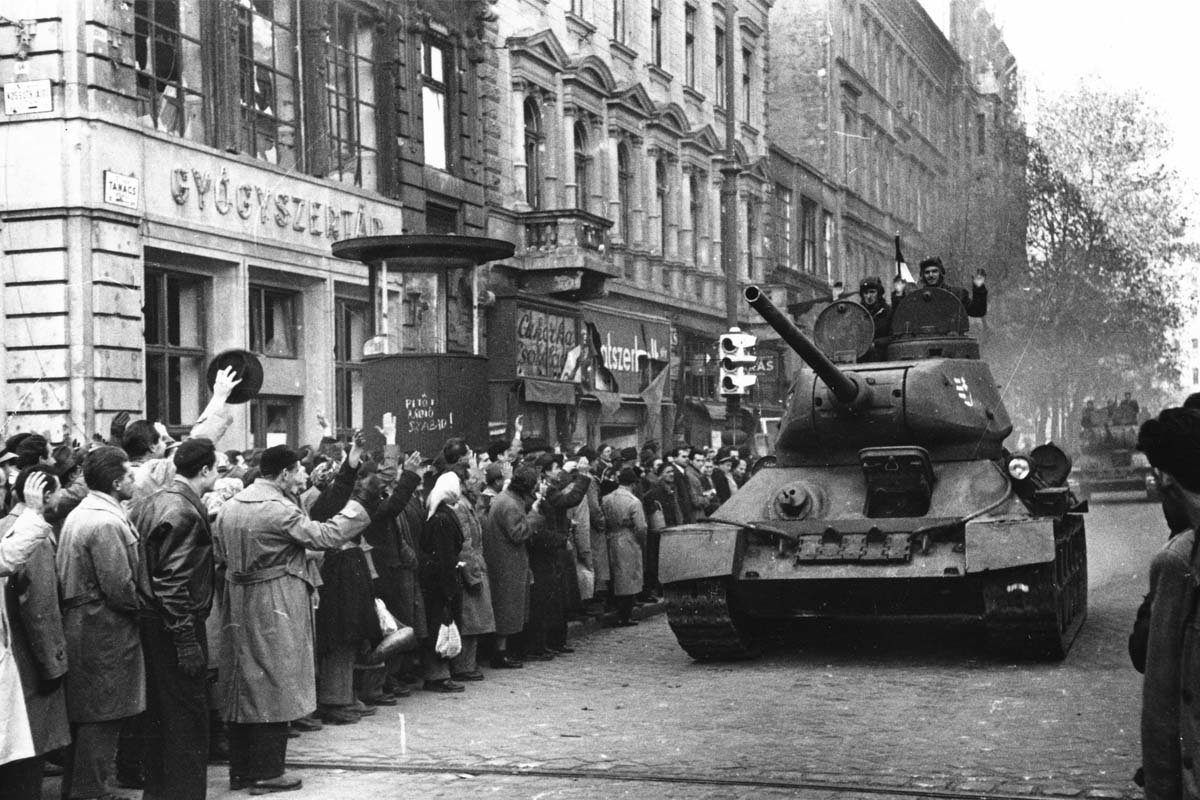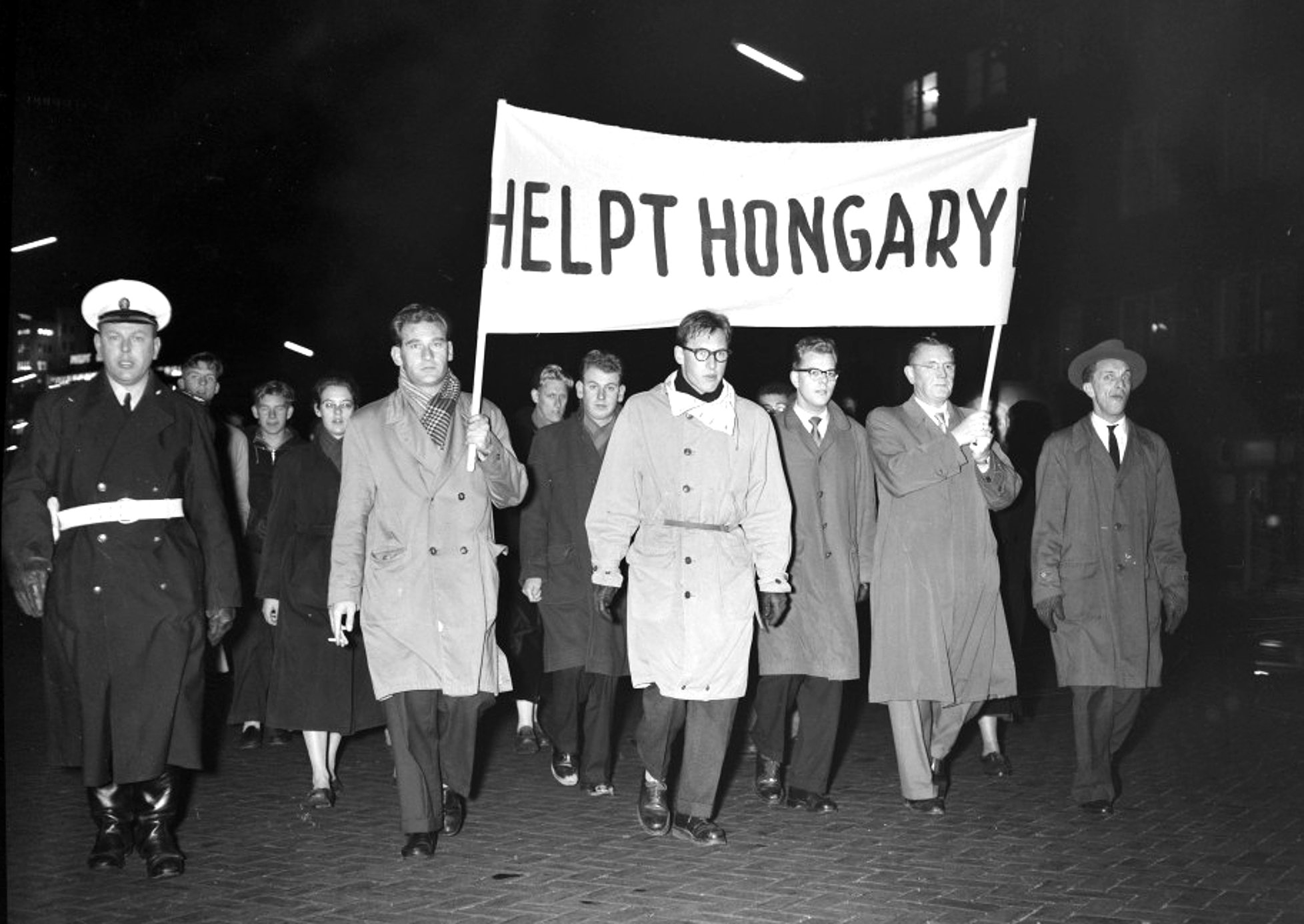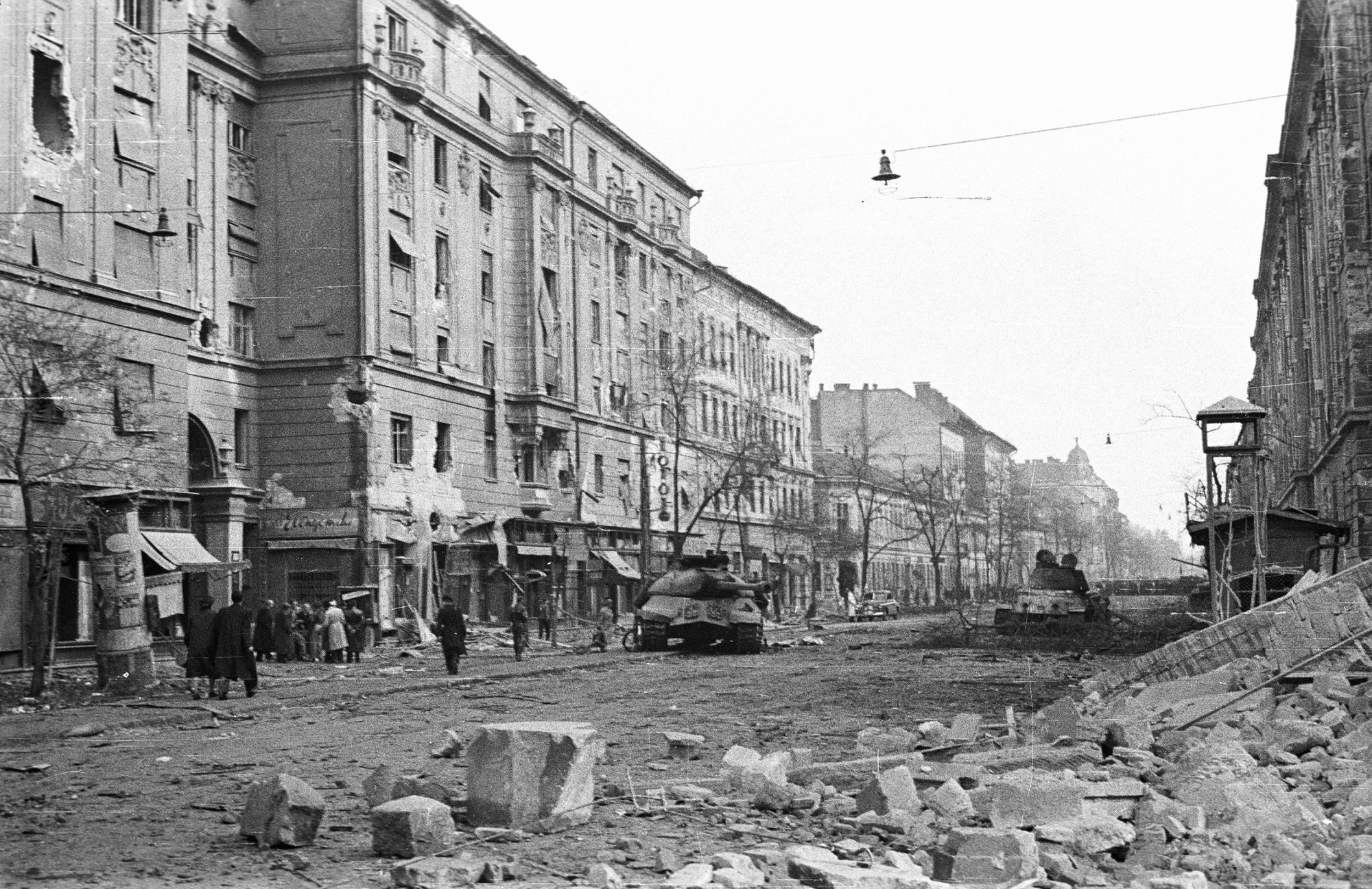The 1956 Hungarian Revolution and the Russian Tanks That Crushed It

A crowd cheers on nationalist Hungarian troops in Budapest during the Hungarian Revolution of 1956. Photo courtesy of Wikimedia Commons.
The year 1956 began with real hope in Russia and the Soviet Union, as its new leader, Nikita Khrushchev, called for the communist nation to improve its ties with Western Europe and the US. But by the end of the year, the Russian leader and the Soviet military made clear that their actions would not match those words: Russian tanks invaded the sovereign capital of Budapest, Hungary, installing a pro-Soviet government and crushing a budding independence movement.
In February 1956, Khrushchev gave a “secret speech” to party leaders calling for de-Stalinization of communist policies and a rapprochement with the West. Rather than live with an assumption of inevitable war, Khrushchev wanted the Soviets to pursue a policy of coexistence with Western powers — half of Europe under Russian control and communist, the other half democratic and aligned with the US. But the speech, which leaked from a secret meeting, sparked a chain reaction of rebellious protests among Russian-dominated countries unhappy with their assigned half.
Perhaps the most grotesque example of Soviet overreaction and military intervention came following the Hungarian Revolution in autumn, later that year.
On Oct. 23, 1956, some 200,000 student protesters marched through Hungary’s capital city of Budapest to reach Magyar Rádió Building, otherwise known as Radio Budapest. The peaceful demonstration developed into a spontaneous revolution. The crowd wanted to broadcast demands for independence and the withdrawal of Soviet troops. Police and soldiers launched tear gas into the crowd, and the police opened fire to quell the agitators.
Erno Gero, Hungary’s last Stalinist leader before the 1956 rebellion, declared martial law and ordered Soviet troops to disperse the crowds.

“By early morning the revolution was in full swing,” The New York Times reported in a timeline of events. “There was guerrilla warfare in the streets against Soviet tanks.”
The protesters-turned-insurgents engaged Russian tanks as they patrolled the streets — some with nothing more than kitchen supplies and gasoline. The Soviets responded with gunfire and tanks. A former British tank officer, Lt. Col. James Noel Cowley, was the military attaché assigned to the British Embassy in Budapest. “The horror and carnage of the scene would appall the most hardened of imaginations,” Cowley later recalled.
Hundreds of Hungarians died in the coming days, and as Budapest came under curfew, fighting spread to the countryside.
The rapid escalation of violence caught the US off guard, especially the CIA. Geza Katona, the only Hungarian-speaking CIA officer on the ground from 1950 to 1957, requested agency policy toward acquiring arms and ammunition.
“We must restrict ourselves to information collection only [and] not get involved in anything that would reveal U.S. interest or give cause to claim intervention” came the response on Oct. 28, according to the National Security Archive. The next day, another response added that “it was not permitted to send U.S. weapons in.”

The messaging behind the scenes didn’t match public projections by President Dwight D. Eisenhower’s administration that purported to support the liberation of the oppressed in communist nations. Besides the failure of the US and Western nations to take action, the world’s perspective also shifted away from Hungary to Egypt when Israel invaded and created a crisis at the Suez Canal.
Left to handle negations with the Soviets alone, Nagy announced Hungary’s neutrality and separation from the Warsaw Pact on Nov. 1. However, this move led the Russians to escalate their military intervention — code-named Operation Whirlwind — to crush the revolt with as many as 1,000 tanks.
“At dawn today, Soviet forces began an attack on our capital, obviously with the aim of toppling the legal, democratic Hungarian government,” Nagy said in a speech broadcast on Saturday, Nov. 4, 1956. “Our troops are fighting. The government is in place. I am making this fact known to our people and the whole world.”
The end of the Hungarian Revolution came in defeat after 12 days of conflict. An estimated 2,500 Hungarians lost their lives. Nagy was ousted from power and kidnapped by the Soviets. He was executed in June 1958. The Russian invasion sent a wave of more than 200,000 refugees into nearby Austria, 30,000 of whom relocated to the United States. A majority moved to New York City and Cleveland, Ohio, where the Hungarian American population today is over 1 million, one of the largest communities of Hungarian descent in the world outside of Hungary.
The 1956 Russian invasion began a series of crackdowns by Soviet forces across the globe.
“There seemed to be no stopping the Red tidal wave,” wrote Bill Hamilton Jr., veteran of the Navy SEALs and the CIA, in his book Night Fighter: An Insider’s Story of Special Ops From Korea to SEAL Team 6. “The United States refused to intervene in the 1956 Hungarian uprising against Soviet rule. Cuba turned communist under a Castro takeover, the first Soviet-backed regime in the western hemisphere. East Germany erected the Berlin Wall. Communist regimes sprang up in South Yemen and Africa. […] South Vietnamese fled the country while an equal number ended up executed or in labor and ‘reeducation’ camps.”
Read Next: Russia’s Invasion To Crush ‘Prague Spring’ Mirrors Ukraine Buildup

Matt Fratus is a history staff writer for Coffee or Die. He prides himself on uncovering the most fascinating tales of history by sharing them through any means of engaging storytelling. He writes for his micro-blog @LateNightHistory on Instagram, where he shares the story behind the image. He is also the host of the Late Night History podcast. When not writing about history, Matt enjoys volunteering for One More Wave and rooting for Boston sports teams.
BRCC and Bad Moon Print Press team up for an exclusive, limited-edition T-shirt design!
BRCC partners with Team Room Design for an exclusive T-shirt release!
Thirty Seconds Out has partnered with BRCC for an exclusive shirt design invoking the God of Winter.
Lucas O'Hara of Grizzly Forge has teamed up with BRCC for a badass, exclusive Shirt Club T-shirt design featuring his most popular knife and tiomahawk.
Coffee or Die sits down with one of the graphic designers behind Black Rifle Coffee's signature look and vibe.
Biden will award the Medal of Honor to a Vietnam War Army helicopter pilot who risked his life to save a reconnaissance team from almost certain death.
Ever wonder how much Jack Mandaville would f*ck sh*t up if he went back in time? The American Revolution didn't even see him coming.
A nearly 200-year-old West Point time capsule that at first appeared to yield little more than dust contains hidden treasure, the US Military Academy said.












